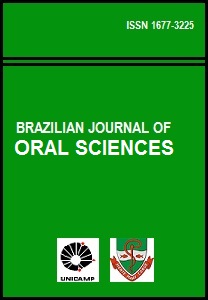Abstract
The aim of this study was to evaluate the radiopacity of four commercially available low-viscosity composites. The lowviscosity composites used in this study were Natural Flow, Flow It, Filtek Flow and Protect Liner F. Five specimens of each material were made in stainless-steel ring moulds of 10 mm diameter and 2 mm height. One specimen of each material and a 10-step aluminium wedge were radiographed in an occlusal film. The reading of the optical density was performed in five different locations in each radiographed specimen. The net optical density was calculated, and then the mean values were obtained, and related with the equivalent thickness of aluminium. The radiopacities of each composite, in millimeters of aluminium were: Flow It (3.24 ± 0.17); Filtek Flow (2.25 ± 0.17); Natural Flow (1.50 ± 0.13); Protect Liner F (<1 mm/Al). Flow It and Filtek Flow presented an acceptable radiopacity according to the ISO Standard 4049. Natural Flow and Protect Liner F did not supply the requirements for radiopacity, thus, these materials could be confounded with secondary caries in some clinical applications, such as restorations or cavity lining.
References
Bayne SC, Thompson JY, Swift EJ Jr, Stamatiades P, Wilkerson M. A characterization of first-generation flowable composites. J Am Dent Assoc. 1998; 129: 567-77.
Swift EJ Jr, Triollo PT Jr, Barkmeier WW, Bird JL, Bounds SJ. Effect of low-viscosity resins on the performance of dental adhesives. Am J Dent. 1996; 9: 100-4.
Rada RE. The versatility of flowable composites. Dentistry Today. 1998; 17: 78-83.
Prager MC. Using flowable composites in direct posterior restorations. Dent Today. 1997; 16: 62-9.
Behle C. Flowable Composites: properties and applications. Dent News Sci. 1998; 10: 347-51.
Payne JH 4th. The marginal seal of class II restorations: flowable composite resin compared to injectable glass ionomer. J Clin Pediatr Dent. 1999; 23:123-30.
Unterbrink GL, Liebenberg WH. Flowable resin composites as “filled adhesives”: Literature review and clinical recommendations. Quintessence Int. 1999; 30: 249-57.
Montes MAJR, de Goes MF, Cunha MRB, Soares AB. A morphological and tensile bond strength evaluation of an unfilled adhesive with low-viscosity composites and a filled adhesive in one and two coats. J Dent. 2001; 29: 435-41.
Frankenberger R, Lopes M, Perdigão J, Abrose WW, Rosa BT. The use of flowable composites as filled adhesives. Dent Mater. 2002; 18: 227-38.
Braga RR, Hilton TJ, Ferracane JL. Contraction stress of flowable composite materials and their efficacy as stressrelieving layers. J Am Dent Assoc. 2003; 134: 721-8.
Montes MAJR, de Goes MF, Ambrosano GMB, Duarte RM, Sobrinho LC. The effect of collagen removal and the use of a low-viscosity resin liner on marginal adaptation of resin composite restorations with margins in dentin. Oper Dent. 2003; 28: 378-87.
Reis AF, Giannini M, Ambrosano GMB, Chan DCN. The effects of filling techniques and a low-viscosity composite liner on bond strength to class II cavities. J Dent. 2003; 31: 59-66.
American Dental Association. Council on Dental Materials and Equipment. Obstacles to the development of a standard for posterior composite resins. J Am Dent Assoc. 1989; 118: 649-51.
Cook WD. An investigation of radiopacity of composite restorative materials. Aust Dent J. 1981; 26: 105-12.
Watts DC. Characterization of aluminum radiopacity standards for restorative materials. J Dent. 1986; 15: 175-7.
Stanford CM, Fan PL, Schoenfeld CM, Knoeppel R, Stanford JW. Radiopacity of light-cured posterior composite resins. J Am Dent Assoc. 1987; 115: 722-4.
Espelid I, Tveit AB, Erickson RL, Keck SC, Glasspole EA. of restorations and detection of secondary caries. Dent Mater. 1991; 7: 114-7.
Murchinson DF, Cherlton DG, Moore WS. Comparative radiopacity of flowable resin composites. Quintessence Int. 1999; 30: 179-84.
Curtis PM Jr., von Fraunhofer JA, Farman AG. The radiographic density of composite restorative resins. Oral Surg Oral Med Oral Pathol. 1990; 70: 226-30.
Goshima T. Radiographic detection of recurrent lesions associated with composite restorations. Oral Surg Oral Med Oral Pathol. 1990; 70: 236-9.
Bouschlicher MR, Cobb DS, Boyer DB. Radiopacity of compomers, flowable and conventional resin composite for posterior restorations. Oper Dent. 1999; 24: 20-5.
Hara AT, Serra MC, Haiter-Neto F, Rodrigues AL Jr. Radiopacity of esthetic restorative materials compared with human tooth structure. Am J Dent. 2001; 14: 383-6.
Attar N, Tam LE, McComb D. Flow, strength, stiffness and radiopacity of flowable resin composites. J Can Dent Assoc. 2003; 69: 516-21.
Sabbagh J, Vreven J, Leloup G. Radiopacity of resin-based materials measured in film radiographs and storage phosphor plate (Digora). Oper Dent. 2004; 29: 677-84.
International Organization for Standardization. ISO 4049: 2000. Dentistry - polymer-based filling, restorative and luting materials. 3rd ed. Geneva, Switzerland: International Organization for Standardization; 2000.
Scoenfeld CM, Lauterschleger EP, Moore BK, Rechtien JJ. Computerized prediction of optical density for diagnostic radiology. J Dent Res. 1977; 56: 1085-92.
Abreu MJN, Tavares D, Vieira DF. Radiopacity of restorative materials. Oper Dent. 1977; 2: 3-16.
Akerboom HB, Kreulen CM, van Amerongen WE, Mol A.
Radiopacity of posterior composite resin, composite resin luting cements, and glass ionomer lining cements. J Prosthet Dent. 1993; 70: 351-5.
Williams JA, Billington RW. The radiopacity of glass ionomer dental materials. J Oral Rehabil. 1990; 17: 245-8.
Jandt KD, Al-Jasser AM, Al-Ateeq K, Volwes RW, Allen GC. Mechanical properties and radiopacity of experimental of glass-silica-metal hybrid composites. Dent Mater. 2002; 18: 429-35.
Goshima T, Goshima Y. Optimum radiopacity of composite inlay materials and cements. Oral Surg Oral Med Oral Pathol. 1991; 72: 257-60.
Tveit AB, Espelid I. Radiographic diagnosis of caries and marginal defects in connection with radiopaque composite fillings. Dent Mater. 1986; 2: 159-62.
Shah PM, Sidhu SK, Chong BS, Ford TR. Radiopacity of resinmodified glass ionomer liners and bases. J Prosthet Dent.
; 77: 239-42.
Sidhu SK, Shah PM, Chong BS, Pitt Ford TR. Radiopacity of resin-modified glass ionomer restorative cements. Quintessence Int. 1996; 27: 639-43.
The Brazilian Journal of Oral Sciences uses the Creative Commons license (CC), thus preserving the integrity of the articles in an open access environment.


